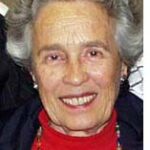By Eileen Wingard

SAN DIEGO — With precise gestures and total command, guest conductor, Elena Schwarz led the San Diego Symphony Sunday, Nov. 17, in a concert that included contemporary music in the first half and a familiar, beloved symphony after intermission.
The program opened with The Chairman Dances (Foxtrot for Orchestra) by John Adams. This 13-minute work is excerpted from Adams’ opera, Nixon in China, and it is when Mao-Tse Tung dances with his wife. In 1972, when Nixon visited China, the foxtrot was popular. The piece begins with repetitive motives, changing in key or instrumentation intermittently, but not including any discernable melody. This is characteristic of minimalism, the type of composing Adams is famous for.
Only about halfway into the piece do we hear discernable melodies. Because of the changing textures and rhythmic pulse, even without a melodic line for much of the time, the work proved to be totally engaging.
The second piece was the Violin Concerto, Concentric Paths, by Thomas Adès. Adès was the composer-in-residence of both the 2023 and 2024 Summerfests of the La Jolla Music Society, so his music is familiar to many in San Diego. He is considered to be Britain’s foremost living composer His surname is of Syrian-Jewish origin. Adès is a pianist and conductor, as well as a composer.
Violinist Leila Josefowicz tackled the technical hurdles of this work with confidence as it opened with the violin bow rapidly rocking over all four strings, then skittering to the highest reaches of the fingerboard, followed by the low notes on the G string. It was not until the second movement that the violinist revealed that she was not only adept at pyrotechnics but could project tones of lyrical beauty.
The final movement began with percussion instruments providing sharp sounds and rhythmic punctuation. The violin once again had some lyrical passages before racing to the concluding chord.
Leila Josefowicz was born in Ontario, Canada, but the family moved to Los Angeles, where she studied with Robert Lipsett at the Colburn School. She later moved to Philadelphia where she studied at the Curtis Institute. She is the recipient of a 2008 MacArthur Fellowship and the 2018 Avery Fisher Prize.
She is known for championing contemporary music and many living composers have written works especially for her. The late Natasha Josefowicz, psychologist, poet and columnist for San Diego Jewish World, was related to the violinist.
After intermission, we were treated to a superb reading of Dvorak’s New World Symphony, written in 1883 and inspired by spirituals and native American dances. Schwarz led the orchestra in a dramatic interpretation without over conducting. Noteworthy was Andrea Overturf’s beautiful English horn solo in the Largo movement. One of Dvorak’s students wrote words to that melody, and it has been sung as a spiritual. The title is, “Goin’ Home.”
The San Diego Symphony deserves to be applauded for exposing audiences to the works of contemporary composers. Yet, after the all-contemporary first half, listening to the New World Symphony with Its familiar themes and singable melodies warmed the heart. It felt like “Goin’ Home.”
*
Eileen Wingard, a retired violinist with the San Diego Symphony, is a freelance writer specializing in coverage of the arts